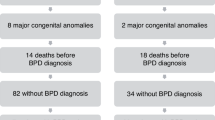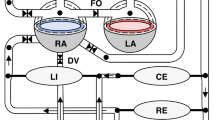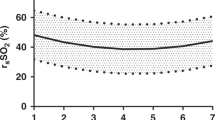Abstract
Background
To examine the impact of PRBC transfusion on pulmonary vascular resistance (PVR), systemic vascular resistance and myocardial function using echocardiography and cerebral and splanchnic tissue oxygenation using near-infrared spectroscopy (NIRS) in premature babies with and without a PDA.
Methods
A prospective observational study of premature infants born <1500 g in receipt of PRBC transfusions beyond 10 days of age. Echocardiography and NIRS monitoring were performed at baseline, during the transfusion and 24 h after transfusion.
Results
Thirty infants with a median gestation of 26.4 [24.8–28.0] weeks were enrolled. Ten infants had a PDA. Following transfusion, a significant decrease in PVR markers occurred in all infants. Right ventricular (RV) function increased following transfusion in the PDA closed group only. Cerebral oxygen saturation increased following transfusion in all infants. Babies in the PDA open group had significantly lower splanchnic oxygen saturations at baseline compared to the PDA closed group which persisted over the study period and were unaltered by transfusion.
Conclusions
PRBC transfusion lowers PVR irrespective of PDA status. Those with a PDA demonstrated a lack of improvement in RV function and splanchnic oxygenation highlighting the impact a PDA has on the neonatal circulation.
Impact
-
The presence or absence of the PDA imposes differential effects on splanchnic oxygenation during red blood cell (PRBC) transfusion in the premature population.
-
This is the first study to assess the impact of the PDA on splanchnic oxygenation via near-infrared spectroscopy (NIRS) during red blood cell transfusion in premature neonates.
-
New insights have been found into the impact of PRBC transfusion on pulmonary vascular resistance, right ventricular function, cerebral and splanchnic oxygenation in the presence and absence of a PDA and emphasises the ongoing impact of ductal patency on gut oxygenation
Similar content being viewed by others
Log in or create a free account to read this content
Gain free access to this article, as well as selected content from this journal and more on nature.com
or
References
Howarth, C., Banerjee, J. & Aladangady, N. Red blood cell transfusion in preterm infants: current evidence and controversies. Neonatology 114, 7–16 (2018).
Villeneuve, A., Arsenault, V., Lacroix, J. & Tucci, M. Neonatal red blood cell transfusion. Vox Sang. 116, 366–378 (2021).
Aher, S., Malwatkar, K. & Kadam, S. Neonatal anemia. Semin. Fetal Neonatal Med. 13, 239–247 (2008).
Barer, G. R., Bee, D. & Wach, R. A. Contribution of polycythaemia to pulmonary hypertension in simulated high altitude in rats. J. Physiol. 336, 27–38 (1983).
Loer, S. A., Scheeren, T. W. & Peters, J. Interaction between haematocrit and pulmonary blood volume on pulmonary vascular flow resistance and pressure flow relationships. Intensive Care Med. 23, 1082–1088 (1997).
Nihill, M. R., McNamara, D. G. & Vick, R. L. The effects of increased blood viscosity on pulmonary vascular resistance. Am. Heart J. 92, 65–72 (1976).
Lister, G., Hellenbrand, W. E., Kleinman, C. S. & Talner, N. S. Physiologic effects of increasing hemoglobin concentration in left-to-right shunting in infants with ventricular septal defects. N. Engl. J. Med. 306, 502–506 (1982).
de Boode, W. P. et al. Recommendations for neonatologist performed echocardiography in Europe: Consensus Statement endorsed by European Society for Paediatric Research (ESPR) and European Society for Neonatology (ESN). Pediatr. Res. 80, 465–471 (2016).
Mertens, L. et al. Targeted Neonatal Echocardiography in the Neonatal Intensive Care Unit: practice guidelines and recommendations for training. Writing Group of the American Society of Echocardiography (ASE) in collaboration with the European Association of Echocardiography (EAE) and the Association for European Pediatric Cardiologists (AEPC). J. Am. Soc. Echocardiogr. 24, 1057–1078 (2011).
El-Khuffash, A. et al. Deformation imaging and rotational mechanics in neonates: a guide to image acquisition, measurement, interpretation, and reference values. Pediatr. Res. 84, 30–45 (2018).
van Laere, D. et al. Application of NPE in the assessment of a patent ductus arteriosus. Pediatr. Res. 84, 46–56 (2018).
Groves, A. M. et al. Introduction to neonatologist-performed echocardiography. Pediatr. Res. 84, 1–12 (2018).
Patel, M. D. et al. Echocardiographic assessment of right ventricular afterload in preterm infants: maturational patterns of pulmonary artery acceleration time over the first year of age and implications for pulmonary hypertension. J. Am. Soc. Echocardiogr. 32, 884.e4–894.e4 (2019).
Levy, P. T. et al. Pulmonary artery acceleration time provides a reliable estimate of invasive pulmonary hemodynamics in children. J. Am. Soc. Echocardiogr. 29, 1056–1065 (2016).
de Boode, W. P. et al. Application of neonatologist performed echocardiography in the assessment and management of persistent pulmonary hypertension of the newborn. Pediatr. Res. 84, 68–77 (2018).
Wilson, J. R., Reichek, N. & Hirshfeld, J. Noninvasive assessment of load reduction in patients with asymptomatic aortic regurgitation. Am. J. Med. 68, 664–674 (1980).
Bruns, N. et al. How to administer near-infrared spectroscopy in critically ill neonates, infants, and children. J. Vis. Exp. https://doi.org/10.3791/61533 (2020).
Saugel, B. et al. Effects of red blood cell transfusion on hemodynamic parameters: a prospective study in intensive care unit patients. Scand. J. Trauma Resusc. Emerg. Med. 21, 21 (2013).
Baron-Stefaniak, J. et al. Transfusion of standard-issue packed red blood cells induces pulmonary vasoconstriction in critically ill patients after cardiac surgery-a randomized, double-blinded, clinical trial. PLoS ONE 14, e0213000 (2019).
Cambonie, G. et al. Myocardial adaptation to anemia and red blood cell transfusion in premature infants requiring ventilation support in the 1st postnatal week. Neonatology 92, 174–181 (2007).
Fredrickson, L. K. et al. Acute physiological effects of packed red blood cell transfusion in preterm infants with different degrees of anaemia. Arch. Dis. Child. Fetal Neonatal Ed. 96, F249–F253 (2011).
Yu, C. W., Sung, R. Y., Fok, T. F. & Wong, E. M. Effects of blood transfusion on left ventricular output in premature babies. J. Paediatr. Child Health 34, 444–446 (1998).
Radicioni, M., Troiani, S. & Mezzetti, D. Functional echocardiographic assessment of myocardial performance in anemic premature infants: a pilot study. Pediatr. Cardiol. 33, 554–561 (2012).
Saleemi, M. S. et al. Myocardial assessment using tissue doppler imaging in preterm very low-birth weight infants before and after red blood cell transfusion. J. Perinatol. 33, 681–686 (2013).
Alkalay, A. L. et al. Hemodynamic changes in anemic premature infants: are we allowing the hematocrits to fall too low? Pediatrics 112, 838–845 (2003).
Mintzer, J. P. et al. Monitoring regional tissue oxygen extraction in neonates <1250 g helps identify transfusion thresholds independent of hematocrit. J. Neonatal Perinat. Med. 7, 89–100 (2014).
Sandal, G. et al. Assessment of red blood cell transfusion and transfusion duration on cerebral and mesenteric oxygenation using near-infrared spectroscopy in preterm infants with symptomatic anemia. Transfusion 54, 1100–1105 (2014).
van Hoften, J. C. et al. Cerebral tissue oxygen saturation and extraction in preterm infants before and after blood transfusion. Arch. Dis. Child. Fetal Neonatal Ed. 95, F352–F358 (2010).
Dani, C. et al. Effect of blood transfusions on cerebral haemodynamics in preterm infants. Acta Paediatr. 91, 938–941 (2002).
Dani, C. et al. Blood transfusions increase cerebral, splanchnic, and renal oxygenation in anemic preterm infants. Transfusion 50, 1220–1226 (2010).
Poon, W. B. & Tagamolila, V. Cerebral perfusion and assessing hemodynamic significance for patent ductus arteriosus using near infrared red spectroscopy in very low birth weight infants. J. Matern. Fetal Neonatal Med. 34, 1645–1650 (2021).
Dix, L. et al. Cerebral oxygenation and echocardiographic parameters in preterm neonates with a patent ductus arteriosus: an observational study. Arch. Dis. Child. Fetal Neonatal Ed. 101, F520–F526 (2016).
Lemmers, P. M. et al. Patent ductus arteriosus and brain volume. Pediatrics 137, e20153090 (2016).
Cohen, E. et al. Reduction in cerebral oxygenation due to patent ductus arteriosus is pronounced in small-for-gestational-age neonates. Neonatology 111, 126–132 (2017).
Chock, V. Y., Rose, L. A., Mante, J. V. & Punn, R. Near-infrared spectroscopy for detection of a significant patent ductus arteriosus. Pediatr. Res. 80, 675–680 (2016).
Silverman, A. & Petersen, N. H. Physiology, Cerebral Autoregulation (StatPearls, 2021).
Ledo, A. et al. Abdominal near-infrared spectroscopy detects low mesenteric perfusion early in preterm infants with hemodynamic significant ductus arteriosus. Neonatology 112, 238–245 (2017).
Aktas, S. et al. Effects of blood transfusion on regional tissue oxygenation in preterm newborns are dependent on the degree of anaemia. J. Paediatr. Child Health 55, 1209–1213 (2019).
Banerjee, J., Leung, T. S. & Aladangady, N. Blood transfusion in preterm infants improves intestinal tissue oxygenation without alteration in blood flow. Vox Sang. 111, 399–408 (2016).
Bailey, S. M., Hendricks-Muñoz, K. D. & Mally, P. V. Variability in splanchnic tissue oxygenation during preterm red blood cell transfusion given for symptomatic anaemia may reveal a potential mechanism of transfusion-related acute gut injury. Blood Transfus. 13, 429–434 (2015).
Marin, T. et al. Red blood cell transfusion-related necrotizing enterocolitis in very-low-birthweight infants: a near-infrared spectroscopy investigation. Transfusion 53, 2650–2658 (2013).
MohanKumar, K. et al. A murine neonatal model of necrotizing enterocolitis caused by anemia and red blood cell transfusions. Nat. Commun. 10, 3494 (2019).
Rai, S. E., Sidhu, A. K. & Krishnan, R. J. Transfusion-associated necrotizing enterocolitis re-evaluated: a systematic review and meta-analysis. J. Perinat. Med. 46, 665–676 (2018).
Funding
The work received funding from the European Society for Paediatric Research (ESPR) Young Investigator START-UP Award 2019, Health Research Board Ireland [NCHF-2017-005] and The National Children’s Research Centre [D/17/7]. The funders had no role in study design, data collection and analysis, decision to publish or preparation of the manuscript.
Author information
Authors and Affiliations
Contributions
Each author has met the Pediatric Research authorship requirements. A.S. obtained funding for the study, provided administrative, technical, and material support for the study, acquired, analysed and interpreted data and drafted the manuscript. S.A. provided administrative, technical, and material support for the study. E.D. provided critical revision of the manuscript for important intellectual content. A.E.-K. conceptualised and designed the study, obtained funding, provided administrative, technical, and material support for the study, acquired, analysed and interpreted data, performed the statistical analysis, drafted the manuscript and provided critical revision of the manuscript for important intellectual content and study supervision. All authors approved the final manuscript as submitted and agree to be accountable for all aspects of the work.
Corresponding author
Ethics declarations
Competing interests
The authors declare no competing interests.
Ethics approval and consent to participate
Informed written consent was obtained from all parents prior to enrolment.
Additional information
Publisher’s note Springer Nature remains neutral with regard to jurisdictional claims in published maps and institutional affiliations.
Rights and permissions
About this article
Cite this article
Smith, A., Armstrong, S., Dempsey, E. et al. The impact of a PDA on tissue oxygenation and haemodynamics following a blood transfusion in preterm infants. Pediatr Res 93, 1314–1320 (2023). https://doi.org/10.1038/s41390-022-01967-3
Received:
Revised:
Accepted:
Published:
Issue date:
DOI: https://doi.org/10.1038/s41390-022-01967-3



